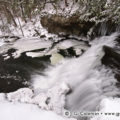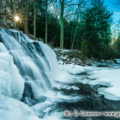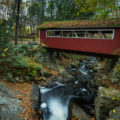If you do most of your landscape photography in the northern reaches of the world, chances are pretty good that your year has a number of distinct stages… some more anticipated than others. Winter offers up landscapes that are marvelously transformed by blankets of snow and glowing ice crystals. Spring is a great time to shoot rivers and waterfalls when they are inundated with melt-water and rain. Then comes Summer, when the northern forests are so alive with foliage that they seem almost tropical. Autumn brings extraordinarily vivid color as leaves begin to change. But what about that period of time from late autumn through early winter when everything looks so bleak? The leaves have fallen from the trees and taken their brilliant colors with them, leaving the forests a tangle of bare, greyish-brown tree trunks. To boot, its still too early to expect a beautiful blanket of snow to enhance the landscape. What you’re left with during this seasonal transition are woodlands that look overwhelmingly colorless and drab. So what’s a photographer to do? The fact of the matter is that it’s entirely possible to take great landscape photographs during this transitional period between Autumn and Winter. You just need the right strategies to make the most of what you’ve got.
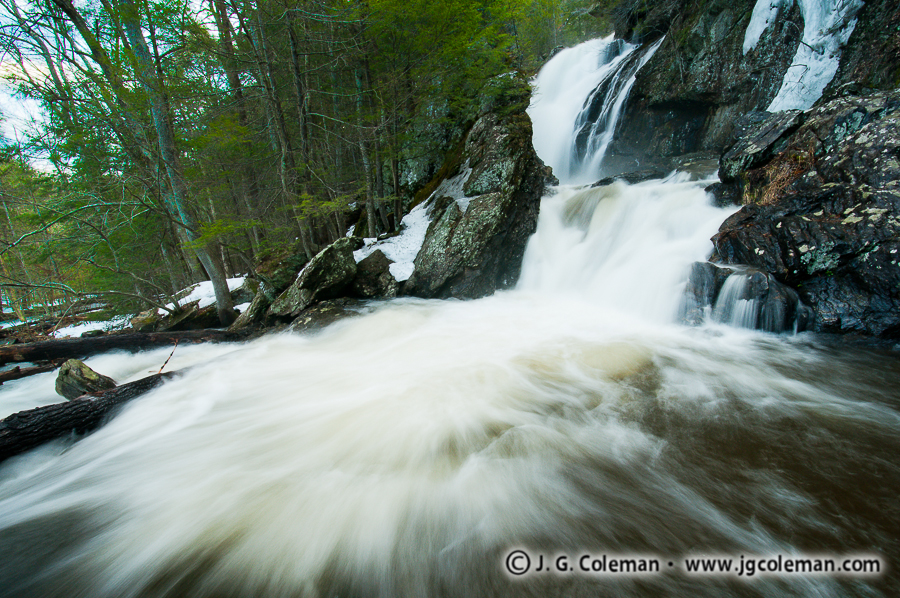
Campbell Falls State Park, New Marlborough, Massachusetts
© 2012 J. G. Coleman
3) Not Every Tree Sheds Its Leaves
The colder weather of Late Autumn can certainly strip the leaves and color from your favorite summertime shooting locations. That’s why it’s important not to cling to these places, but to instead remain flexible and receptive to whatever Mother Nature offers. Set your sights on evergreen forests, for example. Since most pines and hemlocks retain a good deal of their needles during the colder months of the year, you can always be assured that they’ll offer the same feeling of green “vitality” no matter how bleak and bare the oaks, maples and birches may become.
Take a look at this photograph (above) of Campbell Falls that I shot in Massachusetts at Campbell Falls State Park. Although I literally hiked through one foot of snow in mid-March to create this exposure, you’ll notice that the evergreens are still alive with color. If it weren’t for the ice and snow packs on the bedrock surrounding the falls, it would be hard to discern that this photograph was taken in the wintertime.
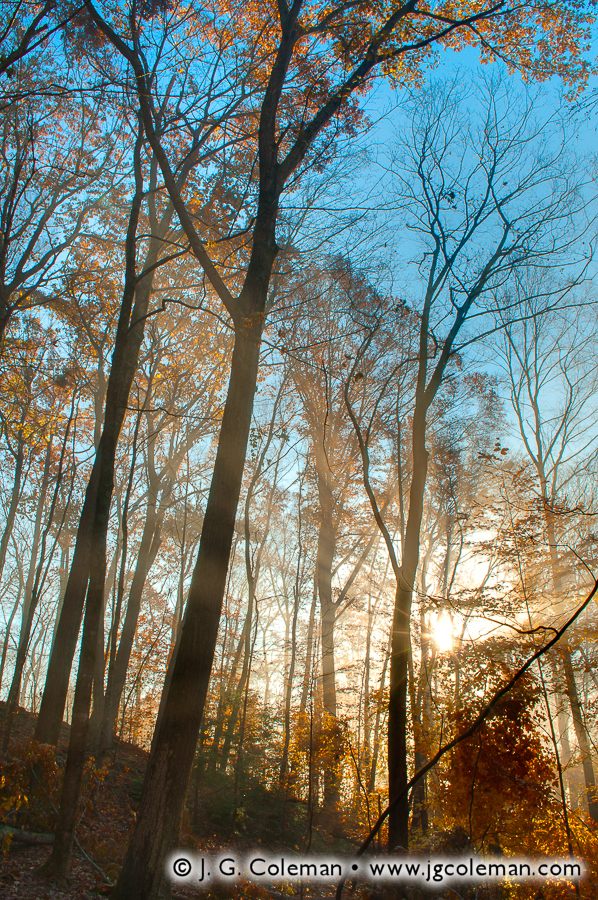
Blackledge Falls Park, Glastonbury, Connecticut
© 2012 J. G. Coleman
2) Take Advantage of the Bare Forest
Sure, the tree limbs may be stripped bare… and yes, it makes the woodlands look pretty bleak. But don’t underestimate the photographic opportunities that are offered by a leaf-less forest. During the summertime, a dense canopy of leaves tends to blot out the sky from the forest floor. Once the trees are bare, however, the sky is free to shine through the tree tops, affording landscape photographers the ability to compose shots that would be difficult to achieve in the warmer months of the year.
This photograph (above) was taken in early November at Blackledge Falls Park in Glastonbury, Connecticut. As you can see, there were very few leaves left on the trees at that point in time, but the rising sun managed to truly bring this landscape to life. A shot like this would’ve been impossible in the summertime, since the forest canopy would’ve obscured the deep blue sky and smothered the beams of sunlight.
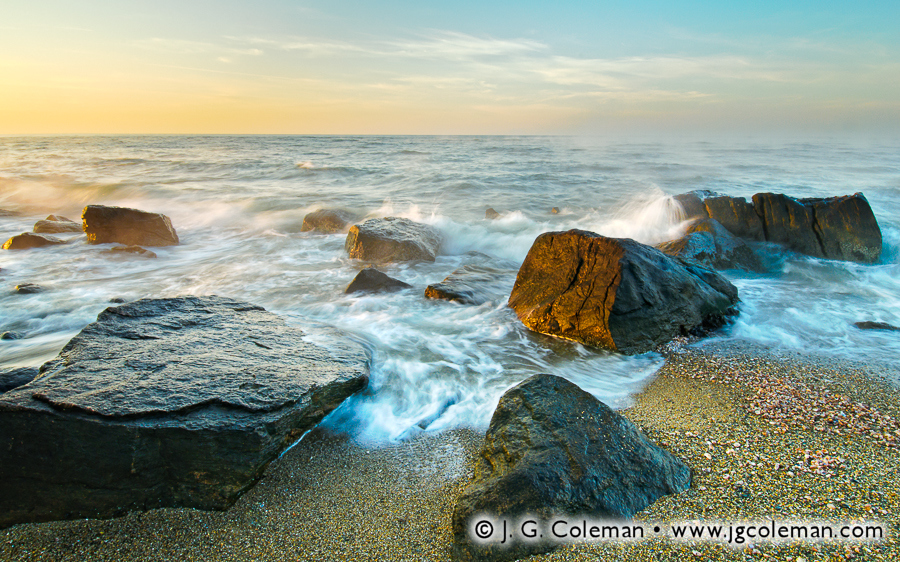
Hammonasset Beach State Park, Madison, Connecticut
© 2012 J. G. Coleman
1) Beaches Are Abandoned
I’ve conducted photo shoots at many of Connecticut’s prominent beaches, including Hammonasset in Madison, Bluff Point in Groton and Rocky Neck in East Lyme. All of these beautiful beaches are protected as state parks, which is great news for thousands upon thousands of Connecticut residents that enjoy swimming and sun-bathing during the warmer months of the year. For a landscape photographer that is trying to capture the “wild” essence of these places, however, throngs of summertime visitors can pose quite an obstacle.
That’s why the vast majority of my beach photography is conducted during the colder months once beach-goers have lost interest. Even though places like Hammonasset Beach get over a million visitors each year, you’ll probably be the only soul in the park if you visit on a cold morning in Late Autumn.
And the beauty of the whole thing is that, while woodlands may indeed be rendered bare by cold temperatures, not too much changes around the seashore. There may be less wildlife to enjoy, but otherwise the landscape itself generally looks no different than it would at any other time of year. The sand is still there, the boulders of glacial moraines certainly aren’t going anywhere, the waves still lap upon the beach with the same rhythm and the sunrises are potentially just as vibrant and remarkable as they are in the Summer.
Less people, same beautiful terrain: that’s a win-win, right? But that’s not all! Many coastal state parks charge a pretty hefty entrance fee in the warmer months of year, but allow free entry once the beach weather has passed. By conducting your seashore shoots in Late Autumn or Winter, you’ll save yourself a pretty penny.
Take, for example, this photograph (above) of the boulders along Meig’s Point at Hammonasset Beach State Park in Madison, Connecticut. Although I produced this photograph in early November, the morning seascape looks just as brilliant and “warm” as it would during the summertime. Looking at how the photograph turned out, you’d hardly suspect that I was literally shivering in the cold morning wind while I set up my tripod.


